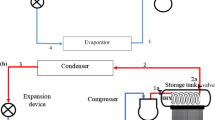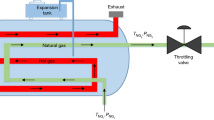Abstract
This work aims to exploit the waste heat from a basic helium Brayton cycle (HBC) driven by a solar power tower (SPT). The two subsystem heat recovery steam generator (HRSG) and vapour absorption cooling system (VACS) have been implemented to recover the waste heat, respectively, for heating to generate steam and cooling for air conditioning. A comprehensive exergy and energy analysis of this proposed trigeneration system was carried out with parametric analysis. For analysis purpose Engineering Equation Solver software has been used. It was concluded that energy and exergy efficiency and net work output of the proposed trigeneration system were observed as 44.96%, 34.15%, 14,562 kW, respectively. The heating production through the HRSG was obtained 8510 kW while the cooling production by VACS as 115.10 kW. Moreover, coefficient of performance (COP) of the VACS subsystem was observed as 0.8015. Energy and exergy efficiency of the SPT operated basic HBC using the subsystems was improved by 58.98% and 12.92%, respectively. Parametric analysis revealed that the helium turbine inlet temperature and solar heliostat field efficiency much affected the trigeneration system performance.














Similar content being viewed by others
Abbreviations
- CR:
-
Central receiver
- HBC:
-
Helium Brayton cycle
- SPT:
-
Solar power tower
- SHE:
-
Solution heat exchanger
- SCO2 :
-
Supercritical CO2
- VACS:
-
Vapour absorption cooling system
- ORC:
-
Organic Rankine cycle
- IHE:
-
Intermediate heat exchanger
- HC:
-
Helium compressor
- HT:
-
Helium turbine
- COP:
-
Coefficient of performance
- CPR:
-
Compressor pressure ratio
- CIT:
-
Compressor inlet temperature
- HTIT:
-
Helium turbine inlet temperature
- DNI:
-
Direct normal irradiation (W/m2)
- HRSG:
-
Heat recovery steam generator
- \(\mathop {{\text{EX}}}\limits^{ \cdot }\) :
-
Rate of exergy (kW)
- h :
-
Specific enthalpy (kJ/kg)
- \(\dot{W}\) :
-
Power (kW)
- \({N}_{{\text{hel}}}\) :
-
Number of heliostats
- \(\dot{Q}\) :
-
Rate of heat interaction (kW)
- T :
-
Temperature (K)
- \(\mathop {{\text{ED}}}\limits^{ \cdot }\) :
-
Exergy destruction rate (kW)
- A :
-
Area (m2)
- s :
-
Specific entropy (kJ/kg K)
- \(\dot{m}\) :
-
Mass flow rate (kg/s)
- c:
-
Condenser
- e:
-
Exit/evaporator
- g:
-
Generator
- j :
-
Particular state
- rec:
-
Receiver
- ref:
-
Reference/reflectivity
- hel:
-
Heliostat
- i:
-
Inlet
- 0:
-
Dead condition
- tri:
-
Trigeneration
- co:
-
Cogeneration
- ex:
-
Exergy
- en:
-
Energy
- \(\eta\) :
-
Efficiency
- ε :
-
Effectiveness
References
Devarajan MM, Kumaraguruparan G (2024) Thermal analysis of solar panel with phase change material: experimental and numerical study. J Braz Soc Mech Sci Eng 46(4):222. https://doi.org/10.1007/s40430-024-04792-3
Khan Y, Raman R, Rashidi MM et al (2023) Thermodynamic analysis and experimental investigation of the water spray cooling of photovoltaic solar panels. J Therm Anal Calorim 148(12):5591–5602. https://doi.org/10.1007/s10973-023-12119-y
Khan Y, Mishra RS (2021) Thermo-economic analysis of the combined solar-based pre-compression supercritical CO2 cycle and organic Rankine cycle using ultra-low GWP fluids. Therm Sci Eng Progress 23:100925
Geneiting T, Lerch S, Schulz B (2023) Probabilistic solar forecasting: benchmarks, post-processing, verification. Sol Energy 252:72–80. https://doi.org/10.1016/j.solener.2022.12.054
Khan Y, Mishra RS, Singh AP (2024) Performance comparison of organic Rankine cycles integrated with solar based combined cycle: a thermodynamic and exergoenvironmental analysis. Proc Inst Mech Eng Part C: J Mech Eng Sci 238(1):233–248. https://doi.org/10.1177/09544062231167069
Al-Sulaiman FA (2014) Exergy analysis of parabolic trough solar collectors integrated with combined steam and organic Rankine cycles. Energy Convers Manage 77:441–449. https://doi.org/10.1016/j.enconman.2013.10.013
Khan Y, Caliskan H, Hong H (2023) A comparative study of combined cycles for concentrated solar power for efficient power generation using low global warming potential (GWP) fluids to reduce environmental effects. IET Renew Power Gener 17(16):3741–3754. https://doi.org/10.1049/rpg2.12866
Zhang Y, Shi X, Zhang H et al (2022) Review on deep learning applications in frequency analysis and control of modern power system. Int J Electr Power Energy Syst 136:107744. https://doi.org/10.1016/j.ijepes.2021.107744
Li H, Hou K, Xu X et al (2022) Probabilistic energy flow calculation for regional integrated energy system considering cross-system failures. Appl Energy 308:118326
Du Q, Wang Y, Zhang D (2021) Numerical investigation on the performance of impeller back seal configuration in a supercritical CO2 radial-inflow turbine. Proc Inst Mech Engin Part C: J Mech Eng Sci 235(22):6152–6169. https://doi.org/10.1177/09544062211009564
Gkountas AA, Benos LT, Nikas KS et al (2020) Heat transfer improvement by an Al2O3-water nanofluid coolant in printed-circuit heat exchangers of supercritical CO2 Brayton cycle. Therm Sci Eng Progr 20:100694
Chai L, Tassou SA (2020) A review of printed circuit heat exchangers for helium and supercritical CO2 Brayton cycles. Therm Sci Eng Prog 18:100543
Al-Sulaiman F, Atif M (2015) Performance comparison of different supercritical carbon dioxide Brayton cycles integrated with a solar power tower. Energy 82:61–71. https://doi.org/10.1016/j.energy.2014.12.070
Osorio JD, Hovsapian R, Ordonez JC (2016) Dynamic analysis of concentrated solar supercritical CO2-based power generation closed-loop cycle. Appl Therm Eng 93:920–934. https://doi.org/10.1016/j.applthermaleng.2015.10.039
Zare V, Hasanzadeh M (2016) Energy and exergy analysis of a closed brayton cycle-based combined cycle for solar power tower plants. Energy Convers Manage 128:227–237. https://doi.org/10.1016/j.enconman.2016.09.080
Miao X, Zhang H, Sun W et al (2022) Optimization of a recompression supercritical nitrous oxide and helium Brayton cycle for space nuclear system. Energy 242:123023
Khan Y, Raman R, Said Z et al (2024) Sustainable power generation through solar-driven integration of brayton and transcritical co2 cycles: a comprehensive 3e (energy, exergy, and exergoenvironmental) evaluation. Global Chall 8(2):2300223. https://doi.org/10.1002/gch2.202300223
Malik A, Zheng Q, Lin A (2019) The design and performance analysis of highly loaded compressor of closed brayton cycle HTGR power plant with helium xenon gas mixture as working fluid. Prog Nucl Energy 117:103084
Zhou J, Ali MA, Zeki FM et al (2023) Thermoeconomic investigation and multi-objective optimization of a novel efficient solar tower power plant based on supercritical Brayton cycle with inlet cooling. Therm Sci Eng Prog 39:101679
Zoghi M, Habibi H, Chitsaz A et al (2021) Exergoeconomic and environmental analyses of a novel trigeneration system based on combined gas turbine-air bottoming cycle with hybridization of solar power tower and natural gas combustion. Appl Therm Eng 188:116610
Mohtaram S, Wu W, Castellanos HG et al (2023) Enhancing energy efficiency and sustainability in ejector expansion transcritical CO2 and lithium bromide water vapour absorption refrigeration systems. Therm Sci and Eng Prog 43:101983
Mishra RS, Singh H (2018) Detailed parametric analysis of solar driven supercritical CO2 based combined cycle for power generation, cooling and heating effect by vapor absorption refrigeration as a bottoming cycle. Therm Sci Eng Prog 8:397–410. https://doi.org/10.1016/j.tsep.2018.09.013
Farges O, B´ezian JJ, Hafi El M (2018) Global optimization of solar power tower systems using a monte carlo algorithm: application to a redesign of the PS10 solar thermal power plant. Renew Energy 119:345–353. https://doi.org/10.1016/j.renene.2017.12.028
Sun L, Wang D, Xie Y (2021) Energy, exergy and exergoeconomic analysis of two supercritical CO2 cycles for waste heat recovery of gas turbine. Appl Therm Eng 196:117337
Zare V, Mahmoudi SMS, Yari M (2015) On the exergoeconomic assessment of employing Kalina cycle for GT-MHR waste heat utilization. Energy Convers Manag 90:364–374. https://doi.org/10.1016/j.enconman.2014.11.039
Xu C, Wang Z, Li X et al (2011) Energy and exergy analysis of solar power tower plants. Appl Therm Eng 31(17–18):3904–3913. https://doi.org/10.1016/j.applthermaleng.2011.07.038
Kerme ED et al (2017) Energetic and exergetic analysis of solar-powered lithium bromide-water absorption cooling system. J Cleaner Prod 151:60–73. https://doi.org/10.1016/j.jclepro.2017.03.060
Author information
Authors and Affiliations
Corresponding author
Ethics declarations
Conflict of interest
The authors confirm that they do not now have any recognized economic or interpersonal disputes that could have affected the findings of this study.
Additional information
Technical Editor: Guilherme Ribeiro.
Publisher's Note
Springer Nature remains neutral with regard to jurisdictional claims in published maps and institutional affiliations.
Rights and permissions
Springer Nature or its licensor (e.g. a society or other partner) holds exclusive rights to this article under a publishing agreement with the author(s) or other rightsholder(s); author self-archiving of the accepted manuscript version of this article is solely governed by the terms of such publishing agreement and applicable law.
About this article
Cite this article
Mishra, S., Singh, R.K. Performance evaluation of absorption cooling system for air conditioning-based novel trigeneration system using solar energy. J Braz. Soc. Mech. Sci. Eng. 46, 354 (2024). https://doi.org/10.1007/s40430-024-04943-6
Received:
Accepted:
Published:
DOI: https://doi.org/10.1007/s40430-024-04943-6




